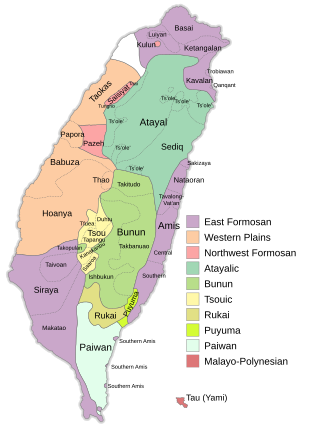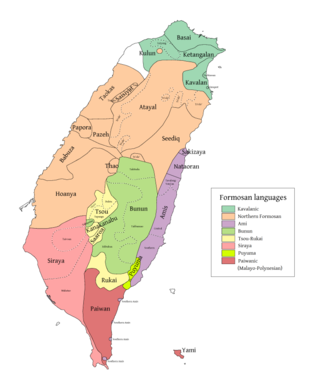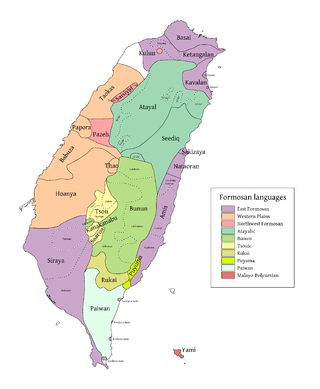Related Research Articles

The Austronesian languages are a language family widely spoken throughout Maritime Southeast Asia, parts of Mainland Southeast Asia, Madagascar, the islands of the Pacific Ocean and Taiwan. They are spoken by about 386 million people. This makes it the fifth-largest language family by number of speakers. Major Austronesian languages include Malay, Javanese, Sundanese, Tagalog (Filipino), Malagasy and Cebuano. According to some estimates, the family contains 1,257 languages, which is the second most of any language family.

The Formosan languages are a geographic grouping comprising the languages of the indigenous peoples of Taiwan, all of which are Austronesian. They do not form a single subfamily of Austronesian but rather up to nine separate primary subfamilies. The Taiwanese indigenous peoples recognized by the government are about 2.3% of the island's population. However, only 35% speak their ancestral language, due to centuries of language shift. Of the approximately 26 languages of the Taiwanese indigenous peoples, at least ten are extinct, another four are moribund, and all others are to some degree endangered.
The Central Philippine languages are the most geographically widespread demonstrated group of languages in the Philippines, being spoken in southern Luzon, Visayas, Mindanao, and Sulu. They are also the most populous, including Tagalog, Bikol, and the major Visayan languages Cebuano, Hiligaynon, Waray, Kinaray-a, and Tausug, with some forty languages all together.

Paiwan is a native language of Taiwan, spoken by the Paiwan, a Taiwanese indigenous people. Paiwan is a Formosan language of the Austronesian language family. It is also one of the national languages of Taiwan.

The Philippine languages or Philippinic are a proposed group by R. David Paul Zorc (1986) and Robert Blust that include all the languages of the Philippines and northern Sulawesi, Indonesia—except Sama–Bajaw and a few languages of Palawan—and form a subfamily of Austronesian languages. Although the Philippines is near the center of Austronesian expansion from Formosa, there is little linguistic diversity among the approximately 150 Philippine languages, suggesting that earlier diversity has been erased by the spread of the ancestor of the modern Philippine languages.

Kavalan was formerly spoken in the Northeast coast area of Taiwan by the Kavalan people (噶瑪蘭). It is an East Formosan language of the Austronesian family.

Rukai is a Formosan language spoken by the Rukai people in Taiwan. It is a member of the Austronesian language family. The Rukai language comprises six dialects, which are Budai, Labuan, Maga, Mantauran, Tanan and Tona. The number of speakers of the six Rukai dialects is estimated to be about 10,000. Some of them are monolingual. There are varying degrees of mutual intelligibility among the Rukai dialects. Rukai is notable for its distinct grammatical voice system among the Formosan languages.

Pazeh and Kaxabu are dialects of an extinct language of the Pazeh and Kaxabu, neighboring Taiwanese indigenous peoples. The language was Formosan, of the Austronesian language family. The last remaining native speaker of the Pazeh dialect died in 2010.
Kanakanavu is a Southern Tsouic language spoken by the Kanakanavu people, an indigenous people of Taiwan. It is a Formosan language of the Austronesian family.
Proto-Austronesian is a proto-language. It is the reconstructed ancestor of the Austronesian languages, one of the world's major language families. Proto-Austronesian is assumed to have begun to diversify c. 4000 BCE – c. 3500 BCE in Taiwan.

Robert A. Blust was an American linguist who worked in several areas, including historical linguistics, lexicography and ethnology. He was Professor of Linguistics at the University of Hawaiʻi at Mānoa. Blust specialized in the Austronesian languages and made major contributions to the field of Austronesian linguistics.

Siraya is a Formosan language spoken until the end of the 19th century by the indigenous Siraya people of Taiwan, derived from Proto-Siraya. Some scholars believe Taivoan and Makatao are two dialects of Siraya, but now more evidence shows that they should be classified as separate languages.

The Tsouic languages are three Formosan languages, Tsou proper and the Southern languages Kanakanavu and Saaroa. The Southern Tsouic languages of Kanakanavu and Saaroa have the smallest phonemic inventories out of all the Formosan languages, with each language having only 13 consonants and 4 vowels. These two languages are highly endangered, as many Southern Tsouic speakers are shifting to Bunun and Mandarin Chinese.

The East Formosan languages consist of various Formosan languages scattered across Taiwan, including Kavalan, Amis, and the extinct Siraya language. This grouping is supported by both Robert Blust and Paul Jen-kuei Li. Li considers the Siraya-speaking area in the southwestern plains of Taiwan to be the most likely homeland of the East Formosan speakers, where they then spread to the eastern coast of Taiwan and gradually migrated to the area of modern-day Taipei.

The Northern Formosan languages is a proposed grouping of Formosan languages that includes the Atayalic languages, the Western Plains languages, and the Northwest Formosan languages.
Proto-Malayo-Polynesian (PMP) is the reconstructed ancestor of the Malayo-Polynesian languages, which is by far the largest branch of the Austronesian language family. Proto-Malayo-Polynesian is ancestral to all Austronesian languages spoken outside Taiwan, as well as the Yami language on Taiwan's Orchid Island. The first systematic reconstruction of Proto-Austronesian ("Uraustronesisch") by Otto Dempwolff was based on evidence from languages outside of Taiwan, and was therefore actually the first reconstruction of what is now known as Proto-Malayo-Polynesian.
There have been various classification schemes for Southeast Asian languages.
This article describes the personal pronoun systems of various Austronesian languages.

Kulon is an extinct language of the Taiwanese aboriginal people that belonged to the Austronesian language family. Very little data is available for Kulon; the primary source is the 60 pages of Tsuchida (1985). Li (2008) follows Tsuchida in linking Kulon with Saisiyat, while Blust (1999) proposes it was more closely related to Pazeh.
The East Asian languages are a language family proposed by Stanley Starosta in 2001. The proposal has since been adopted by George van Driem and others.
References
- Blust, Robert A. 2001. "Historical morphology and the spirit world: *qali/kali-prefixes in Austronesian languages." In John Bradshaw and Kenneth L. Rehg (eds.) Issues in Austronesian Morphology. A festschrift for Byron W. Bender. Canberra: Pacific Linguistics, 15–73.
- Blust, Robert A. 2009. The Austronesian Languages. Canberra: Pacific Linguistics, Research School of Pacific and Asian Studies, Australian National University. ISBN 0-85883-602-5, ISBN 978-0-85883-602-0.
- Li, Paul Jen-kuei and Shigeru Tsuchida. 2009. "Yet more Proto Austronesian infixes." Discovering history through language: papers in honour of Malcolm Ross, 345–362. Canberra: Pacific Linguistics.
- Mintz, Malcolm W. 1992. "The fossilised affixes of Bikol." Currents in Pacific linguistics: papers on Austronesian languages and ethnolinguistics in honour of George W. Grace, 265–291. Canberra: Pacific Linguistics.